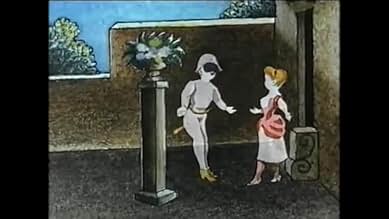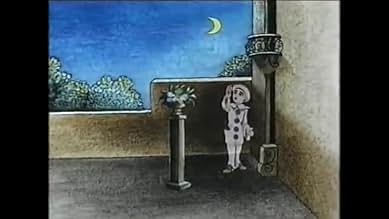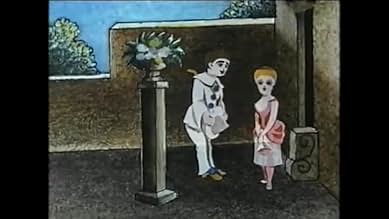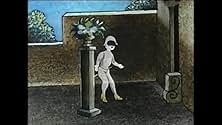IMDb-BEWERTUNG
6,4/10
2238
IHRE BEWERTUNG
Füge eine Handlung in deiner Sprache hinzuOne night, Arlequin come to see his lover Colombine. But then Pierrot knocks at the door and Colombine and Arlequin hide. Pierrot starts singing but Arlequin scares him and the poor man goes... Alles lesenOne night, Arlequin come to see his lover Colombine. But then Pierrot knocks at the door and Colombine and Arlequin hide. Pierrot starts singing but Arlequin scares him and the poor man goes away.One night, Arlequin come to see his lover Colombine. But then Pierrot knocks at the door and Colombine and Arlequin hide. Pierrot starts singing but Arlequin scares him and the poor man goes away.
- Regie
- Drehbuch
Empfohlene Bewertungen
History lesson time! Back when films were viewed as magical gimmicks rather than an art form, inventor Reynaud made advancements on the standard zoetrope that children would be hypnotised by, and patented the praxinoscope. The difference? The ability to give further dimensions to the strips that are used to project a flowing film. And that's where Pauvre Pierrot comes in (roughly translated as "Poor Pete"), part one of three short stories that combined to produce Reynaud's 'Pantomimes Lumineuses'. Whilst the other two are considered lost, this third has had four minutes restored from its original fifteen minute runtime. And much to my surprise, it's just as viewable now as it was back in 1892.
The straightforward plot consists of a man teasing another man to scare him away from a woman he was trying to woo. The limited fluidity resulted in the story being as clunky as various frame transitions (occasionally pausing on every third strip), but for such an experimental ancient silent film, the story isn't exactly at the forefront. It's the innovation, and Reynaud was an innovator through and through. Just by staring at the detailed drawings that are able to exude featured facial expressions, you get a sense of commitment from Reynaud. The lack of narrative interest is seemingly masked by the grandeur of this static backdrop, and it's still stupendously amazing to watch today. Will I remember it next week? Most likely not. However it's imperative to appreciate the milestones that paved the way for films today, and Pauvre Pierrot is a technical achievement.
The straightforward plot consists of a man teasing another man to scare him away from a woman he was trying to woo. The limited fluidity resulted in the story being as clunky as various frame transitions (occasionally pausing on every third strip), but for such an experimental ancient silent film, the story isn't exactly at the forefront. It's the innovation, and Reynaud was an innovator through and through. Just by staring at the detailed drawings that are able to exude featured facial expressions, you get a sense of commitment from Reynaud. The lack of narrative interest is seemingly masked by the grandeur of this static backdrop, and it's still stupendously amazing to watch today. Will I remember it next week? Most likely not. However it's imperative to appreciate the milestones that paved the way for films today, and Pauvre Pierrot is a technical achievement.
Pauvre Pierrot (1892)
This French film is considered one of the first animated movies ever made. From original reports it seems that the movie lasted longer than what's available in its current version but even at just four-minutes you can't help but be somewhat amazed at what great quality the film actually is. The plot is quite simple and deals with two men and a woman that they both want.
I will just leave the story at that but the main reason to watch this is for the beautiful animation. Now, it should go without saying but this movie was made in 1892 so one really shouldn't be expecting the work of Walt Disney. The film has a very fresh look to it and I must say that the colorful background is certainly the highlight.
This French film is considered one of the first animated movies ever made. From original reports it seems that the movie lasted longer than what's available in its current version but even at just four-minutes you can't help but be somewhat amazed at what great quality the film actually is. The plot is quite simple and deals with two men and a woman that they both want.
I will just leave the story at that but the main reason to watch this is for the beautiful animation. Now, it should go without saying but this movie was made in 1892 so one really shouldn't be expecting the work of Walt Disney. The film has a very fresh look to it and I must say that the colorful background is certainly the highlight.
Cute and strange; oh, and it's the first animated thing put to film... ever. Impressive for that alone, AND it has a story! It may not be too deep, and may be a little confusing (what's with the guy that comes out of nowhere and steals the guy's ukulele or whatever it is, is he a ghost?) But it does have a beginning, middle and sort of an end, maybe, arguably. For what this french animator was able to accomplish - and did I mention in COLOR no less - and for the simple fact that this is one of the major accomplishments of that century, to get something with images moving, albeit jerkily, I say you should check out all four minutes on YouTube or wherever silent film shorts are sold.
J. Stuart Blackton's 'Humorous Phases of Funny Faces (1906)' is generally held as the first animated film. Indeed, it was the first animated film made on motion-picture film, but such history is nevertheless unfair to Émile Reynaud, who, fourteen years earlier, was projecting moving animated images to delighted audiences. 'Pauvre Pierrot (1892)' is one of the director's few surviving works (most were, in a fit of frustration, discarded into the Seine by the director himself), and such a colourful and charming curio remains a delight to behold.
Reynaud animated each frame himself – 500 in total (36 metres long) – and extended the film to 12-15 minutes by personally manipulating the picture-bands during the projection. The story told is a simple one: Pierrot and Arlequin compete for the romantic attention of Colombine, a beautiful maiden. One potential suitor attempts to charm the good lady with a lute performance, but his competitor goes one better with a baton or sword of some sort.
Reynaud's moving picture show, billed as "Théâtre Optique" or "Pantomimes Lumineuses," included a triple-bill of three films: 'Pauvre Pierrot,' 'Un bon bock (1892),' and 'Le Clown et ses chiens (1892).' One contemporary newspaper reported that Reynaud "creates characters with expressions and movements so perfect that they give the complete illusion of life." The show was initially a great success, but, in 1918, Reynaud died a poor man. His delicate work, prone to rapid degradation, could not compete with the Lumière brothers' cinematograph, which depicted real-life, and not merely an animated approximation.
Reynaud animated each frame himself – 500 in total (36 metres long) – and extended the film to 12-15 minutes by personally manipulating the picture-bands during the projection. The story told is a simple one: Pierrot and Arlequin compete for the romantic attention of Colombine, a beautiful maiden. One potential suitor attempts to charm the good lady with a lute performance, but his competitor goes one better with a baton or sword of some sort.
Reynaud's moving picture show, billed as "Théâtre Optique" or "Pantomimes Lumineuses," included a triple-bill of three films: 'Pauvre Pierrot,' 'Un bon bock (1892),' and 'Le Clown et ses chiens (1892).' One contemporary newspaper reported that Reynaud "creates characters with expressions and movements so perfect that they give the complete illusion of life." The show was initially a great success, but, in 1918, Reynaud died a poor man. His delicate work, prone to rapid degradation, could not compete with the Lumière brothers' cinematograph, which depicted real-life, and not merely an animated approximation.
This is a very, very, very, very impressive movie for 1892. Yes, 1892! Edison was still experimenting with his Kinetoscope in America, Etienne-Jules Marey was using his Chronophotographic Gun to shoot film experiments, and films were, like, 3 seconds! Charles-Emile Reynaud's "Pauve Pierrot" originally ran 15 minutes, is in painted color by Reynaud himself, and (drum-roll, please) is animated! 1892, and this is the first cartoon! It consists of 500 images, tells a story, and is something you'd think came much, much later than this!
That's not to say it doesn't have any flaws. It definitely does. For one thing, while this is animation, it is very, very primitive looking by today's standards. The figures' movements are jerky, and at times they don't move at all. One particularly poorly animated spot is when Colombine comes out to meet Harlequin, as well as when she opens the door for Pierrot. Also, while sometimes there is some cutting closer to the figures, we mostly view what's going on from a single vantage point. If you decide to see this, bear in mind that, while ground-breaking, the animation isn't anything like what you'd see nowadays.
It's so sad. So much of Reynaud's work is lost today. The only other available cartoon from him is "Autour d'un Cabine" from 1894. His other two cartoons, "Le Clown et ses Chiens" and "Un Bon Bock" were both thrown into the Seine by Reynaud himself. Luckily, he spared these two movies so they could be seen and appreciated today.
That's not to say it doesn't have any flaws. It definitely does. For one thing, while this is animation, it is very, very primitive looking by today's standards. The figures' movements are jerky, and at times they don't move at all. One particularly poorly animated spot is when Colombine comes out to meet Harlequin, as well as when she opens the door for Pierrot. Also, while sometimes there is some cutting closer to the figures, we mostly view what's going on from a single vantage point. If you decide to see this, bear in mind that, while ground-breaking, the animation isn't anything like what you'd see nowadays.
It's so sad. So much of Reynaud's work is lost today. The only other available cartoon from him is "Autour d'un Cabine" from 1894. His other two cartoons, "Le Clown et ses Chiens" and "Un Bon Bock" were both thrown into the Seine by Reynaud himself. Luckily, he spared these two movies so they could be seen and appreciated today.
Wusstest du schon
- WissenswertesThe cartoon was hand drawn on hundreds of sheets of glass, each inlaid in a leather strips, through which a light was shone projecting the figures on a backdrop, as it was spooled from one reel to another, much like a modern film reel.
- VerbindungenFeatured in La magie Méliès (2002)
Top-Auswahl
Melde dich zum Bewerten an und greife auf die Watchlist für personalisierte Empfehlungen zu.
Details
- Erscheinungsdatum
- Herkunftsland
- Sprache
- Auch bekannt als
- Armer Pierrot
- Weitere beteiligte Unternehmen bei IMDbPro anzeigen
- Laufzeit
- 5 Min.
- Sound-Mix
Zu dieser Seite beitragen
Bearbeitung vorschlagen oder fehlenden Inhalt hinzufügen


















